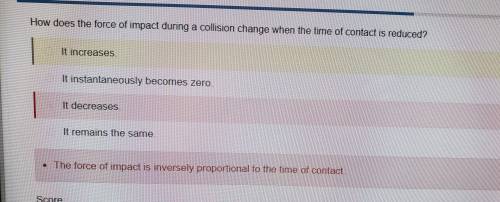Please explain these correct answers for me
...

Answers: 3


Another question on Physics

Physics, 21.06.2019 22:30
Follow these directions and answer the questions. 1. shine a pencil-thin beam of light on a mirror perpendicular to its surface. (if you don't have a laser light as suggested in the video, you can make a narrow beam from a flashlight by making a cone from black construction paper and taping it over the face of the flashlight.) how does the light reflect? how does the relationship of incident to reflected ray relate to the reflection of water waves moving perpendicular to a barrier? 2. shine a pencil-thin beam of light on a mirror standing on a sheet of paper on the table (or floor) so that you can mark the incident ray and reflected ray. (you can support the mirror from the back by taping it to a wooden block.) 3. mark a line on the paper representing the reflective surface. (the reflective surface of a mirror is usually the back edge.) 4. draw a dashed line perpendicular to the mirror surface at a point where the incident and reflected ray meet. this perpendicular is called a normal to the surface. 5. measure the angles between the rays and the normal. the angle of incidence is the angle formed by the incident ray and the normal to the surface. the angle formed by the reflected ray and normal is called the angle of reflection (r). what is the angle of incidence? what is the angle of reflection? 6. repeat for several different angles. (see report sheet for details.) what appears to be the relationship between the angle of incidence and angle of reflection? in science 1204, what was the relationship for these two angles made by the reflection of waves in a ripple tank? 7. roll a ball bearing so that it hits a fixed, hard surface (a metal plate) at several angles (including head-on). observe the way in which the ball bearing reflects. what generalization can you make about how a ball bearing reflects from a wall? have you proved that light can only behave like a wave?
Answers: 1

Physics, 22.06.2019 08:40
When temperature of a substance increases, of its particles increase resulting in more between particles. real world applications of thermal expansion absolute zero (-273 degrees c) is the lowest possible temperature on the kelvin scale. it is a measure of where a substance has no kinetic energy. heat is a process of the . energy flows spontaneously from a object to a until equilibrium is reached. heat is measured in heat is transferred throughis a method of heat transfer that occurs between particles of matter that are in direct contact with each other. are poor conductors that impede / reduce the rate of heat transfer. is a method of heat transfer that occurs in fluids (non-solids) by means of currents. real world application of convectiona method of heat transfer through electromagnetic waves. when energy moves from one object to another inside a closed system, no energy is or in the system in the transaction. systems will spontaneously move to a state of organized energy or high disorder over time called
Answers: 2

Physics, 22.06.2019 09:00
In a heat engine if 1000 j of heat enters the system the piston does 500 j of work, what is the final internal energy of the system if the initial energy was 2000 j? 1. write the equation 2.list out your known variables 3.plug the numbers into the equations 4.solve 5.write your solution statement that includes initial energy and final
Answers: 1

Physics, 22.06.2019 11:00
I'm thinking it's 2 you are asked to explain the earth's magnetic field. which is the best reply? 1. the earth's magnetic south is similar to the north pole of a magnet. 2. the earth's core has a strong magnetic charge similar to the south pole of a magnet. 3. the earth's geomagnetic south is similar to the south pole of a magnet. 4. the earth's magnetic charge is not centered at either pole; it varies based on location.
Answers: 1
You know the right answer?
Questions



Mathematics, 12.07.2019 15:30



Spanish, 12.07.2019 15:30

Mathematics, 12.07.2019 15:30


Mathematics, 12.07.2019 15:30


History, 12.07.2019 15:30



English, 12.07.2019 15:30


History, 12.07.2019 15:30



Chemistry, 12.07.2019 15:30

English, 12.07.2019 15:30







